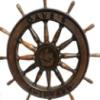-
Posts
3,076 -
Joined
-
Last visited
Reputation Activity
-
 Jaager got a reaction from EricWilliamMarshall in Sovereign of The Seas by SawdustDave - FINISHED
Jaager got a reaction from EricWilliamMarshall in Sovereign of The Seas by SawdustDave - FINISHED
I got plans for HMS Prince a long time ago. I later worked thru part of the exercise in Deane's Doctrine in developing plans for a first rate of about 1670. In doing this, I learned that vessel length was based on touch of the keel. When I checked the plans of HMS Prince, I found that its length was based on LBP, not touch. The model plans were about 25-30 feet too short. Because they used the model in the Science Museum to provide the deck details, the deck is a bit crowded - trying to squeeze in the hatches and bits and such and the gunports were too close together. Plus, the model looks short and fat.
If your plans are too short, you can measure the distance from the front edge of the keel to the scraph of the stem at the gundeck and the back edge of the keel to the scarph on the sternpost. Add this distance to the center of the Keel piece at the dead flat (midship mold). Make two more copies of the midship mold and add them on either side of "0" and call one "A" and the other "1". You will need to adjust the gunports, and deck furniture between the quarterdeck and forecastle, but you will have the correct distance to place it all. This will save having to redraft the hull lines
-
 Jaager got a reaction from CaptainSteve in Sovereign of The Seas by SawdustDave - FINISHED
Jaager got a reaction from CaptainSteve in Sovereign of The Seas by SawdustDave - FINISHED
There are 2 relatively recent books about this vessel: authors - James Sephton, 2011 and Hendrick Basmann, 2002.
Before you cut wood, you may wish to check the following:
Possible - about the time that these plans were drawn, there was misunderstanding about hull length.
After about 1700, the given length was that of LBP (length between perpendiculars) with the perpendiculars being where the inside of the scarph at the stempost and sternpost meet the line of the gundeck (or main deck). There were slight variations in nominclature. There was at least one set of plans for a 17th century warship drawn using this to match the published hull length.
Before ~1700, the given length was "touch" ( the portion of the keel assembly that is congruent with the baseline). The stem and sternpost made the actual length longer.
If the published length matches what would be LBP - then the plans have the vessel about 20% too short.
-
 Jaager got a reaction from avsjerome2003 in Sovereign of The Seas by SawdustDave - FINISHED
Jaager got a reaction from avsjerome2003 in Sovereign of The Seas by SawdustDave - FINISHED
There are 2 relatively recent books about this vessel: authors - James Sephton, 2011 and Hendrick Basmann, 2002.
Before you cut wood, you may wish to check the following:
Possible - about the time that these plans were drawn, there was misunderstanding about hull length.
After about 1700, the given length was that of LBP (length between perpendiculars) with the perpendiculars being where the inside of the scarph at the stempost and sternpost meet the line of the gundeck (or main deck). There were slight variations in nominclature. There was at least one set of plans for a 17th century warship drawn using this to match the published hull length.
Before ~1700, the given length was "touch" ( the portion of the keel assembly that is congruent with the baseline). The stem and sternpost made the actual length longer.
If the published length matches what would be LBP - then the plans have the vessel about 20% too short.
-
 Jaager got a reaction from SawdustDave in Sovereign of The Seas by SawdustDave - FINISHED
Jaager got a reaction from SawdustDave in Sovereign of The Seas by SawdustDave - FINISHED
There are 2 relatively recent books about this vessel: authors - James Sephton, 2011 and Hendrick Basmann, 2002.
Before you cut wood, you may wish to check the following:
Possible - about the time that these plans were drawn, there was misunderstanding about hull length.
After about 1700, the given length was that of LBP (length between perpendiculars) with the perpendiculars being where the inside of the scarph at the stempost and sternpost meet the line of the gundeck (or main deck). There were slight variations in nominclature. There was at least one set of plans for a 17th century warship drawn using this to match the published hull length.
Before ~1700, the given length was "touch" ( the portion of the keel assembly that is congruent with the baseline). The stem and sternpost made the actual length longer.
If the published length matches what would be LBP - then the plans have the vessel about 20% too short.
-
 Jaager got a reaction from trippwj in Seeking information on determining load waterline
Jaager got a reaction from trippwj in Seeking information on determining load waterline
I have always thought that they went at this from the opposite direction. The hull form developed to work from the waterline that designer drafts (or from the Dutch style -had in his head) and then when a float, blasted to meet that waterline.
-
 Jaager got a reaction from shihawk in Household Ammonia
Jaager got a reaction from shihawk in Household Ammonia
Lignin is soluble in pure Ammonia, not aqueous ammonia, and certainly not the 5% solution that is household ammonia. For our purposes it is the heat that makes lignin pliable. Water/steam transfers heat much more efficiently than dry wood. Using ammonia instead of plain water just adds an unnecessary component.
-
 Jaager got a reaction from Keith_W in Household Ammonia
Jaager got a reaction from Keith_W in Household Ammonia
Lignin is soluble in pure Ammonia, not aqueous ammonia, and certainly not the 5% solution that is household ammonia. For our purposes it is the heat that makes lignin pliable. Water/steam transfers heat much more efficiently than dry wood. Using ammonia instead of plain water just adds an unnecessary component.
-
 Jaager got a reaction from mtaylor in Household Ammonia
Jaager got a reaction from mtaylor in Household Ammonia
Lignin is soluble in pure Ammonia, not aqueous ammonia, and certainly not the 5% solution that is household ammonia. For our purposes it is the heat that makes lignin pliable. Water/steam transfers heat much more efficiently than dry wood. Using ammonia instead of plain water just adds an unnecessary component.
-
 Jaager got a reaction from shihawk in Recycling old wood
Jaager got a reaction from shihawk in Recycling old wood
POF- Plank on Frame actually uses fairly small individual components. The goal is to simulate prototype construction in scale. The largest pieces tend to be made up of subunits (keel, stem, frames) . There are many books and articles (some original, some secondary sources) showing how this was done.
POB - Plank on Bulkhead ( actually plank on mold as in the wooden ship era, only Chinese ships had actual bulkheads ) the molds are large - usually plywood - everything else is pretty much the same as POF. If you wish to scratch build in POB style, you could make your molds from the Oak - either straight out pieces, or band saw veneer slices and laminate alternate grain layers to make your own plywood.
The building style that uses large pieces of wood is Solid Hull. An Oak solid hull would be strong. But man! - the work in carving Oak instead of White Pine or Basswood/Linden....
-
 Jaager got a reaction from Modeler12 in Scroll saw operation
Jaager got a reaction from Modeler12 in Scroll saw operation
Jay,
I was looking at your 2nd example and envisioning the top middle block as being an epoxyed Cool Block to reduce friction, instead of what looks like Ebony. The color is close to Cool Block color.
-
 Jaager got a reaction from shihawk in Recycling old wood
Jaager got a reaction from shihawk in Recycling old wood
Paraffin, latex paint, oil based paint, varnish, shellac, polyurethane finish, just something to keep water from leaving the wood from the cut ends of the fiber straws instead of the sides. Wood preservative would probably be very bad.
Wood really is like a bundle of soda straws. The function of the straws is to transport water. Water leaves so much more rapidly from the cut ends than thru the sides of the straws that stresses develop from uneven water loss and the wood cracks and splits (checking). What you want to do is block the open ends. Keep an eye on the painted ends and reapply the coating if checking starts to occur.
I think bowing and twisting is more a function of the plane of the cut of the billets - with quarter sawn being less prone to this and every species of tree having its own degree of amount. Leaving the wood as a log to dry - there would be much less bowing and twisting of the final planks, but a much longer drying time and often much more checking and splitting - sometimes making it difficult to get anything useful.
-
 Jaager got a reaction from shihawk in Recycling old wood
Jaager got a reaction from shihawk in Recycling old wood
Almost any wood can be air dried, Birch and Beech, I am pretty confident can be.
The main one that I know to be a problem is Holly. There is an extremely aggressive fungus - Blue Mold - that can invade the green wood faster than it air dries. This species needs to be kiln dried.
A kiln is just a hot box with an exhaust function to remove the water vapor. Since we are not making full size furniture, the size of the pieces can be what cabinet makers think is scrap and cutoffs. The temp and exhaust rates can be much more forgiving with smaller pieces. End grain still needs to be sealed to reduce checking, but that is also the situation with air drying.
-
 Jaager got a reaction from hornet in Recycling old wood
Jaager got a reaction from hornet in Recycling old wood
There are several species of wood that go by mahogany. 40 years is not that long ago as far as substitutes for the traditional species of mahogany being slipped in, so based on name alone, it would be difficult to determine just which species it is.
As far as modeling use, both Oak and Mahogany are open pore and the grain of Oak does not scale down to 1:50 - 1:100 range all that well. If you intend to seal and paint, both are suitable for frame structures, planking, deck structures. You would need to fill the pores before the finish paint to get a smooth finish.
If you are contemplating harvesting and being your own sawyer and millwright, I offer the following:
A band saw is much better suited to get from round stock to finished planks. Just make sure the motor is powerful enough - 1.5 HP at least.
In general it takes 1 year for a 1 inch thick plank to air dry. So If you get round stock into 2 inch billets, it is ready to use in 2 years.
If you intend to go traditional POF with as much natural wood as possible, Investigate which species of wood are grown in Northern Ireland. You want closed pore, hard, tight grain and if possible low contrast between Spring and Summer bands.
Fruit wood - Apple, Pear, Plum, Crab Apple, are ideal.
Maple is excellent and what you call Sycamore, is a member of the maple family (Acer). In North America - what we call a Sycamore, is in an entirely different family and has a less desirable grain pattern.
I am guessing that there is a history of formal gardens where you are. You may be able to get some Buxus sempervirens (real boxwood).
There are species of smaller trees that grow in your hedgerows - not large enough to be commercial product, but certainly worth your time and exploration.
Beech and Birch are usable species and may be available from local hardwood sellers.
-
 Jaager got a reaction from shihawk in Recycling old wood
Jaager got a reaction from shihawk in Recycling old wood
There are several species of wood that go by mahogany. 40 years is not that long ago as far as substitutes for the traditional species of mahogany being slipped in, so based on name alone, it would be difficult to determine just which species it is.
As far as modeling use, both Oak and Mahogany are open pore and the grain of Oak does not scale down to 1:50 - 1:100 range all that well. If you intend to seal and paint, both are suitable for frame structures, planking, deck structures. You would need to fill the pores before the finish paint to get a smooth finish.
If you are contemplating harvesting and being your own sawyer and millwright, I offer the following:
A band saw is much better suited to get from round stock to finished planks. Just make sure the motor is powerful enough - 1.5 HP at least.
In general it takes 1 year for a 1 inch thick plank to air dry. So If you get round stock into 2 inch billets, it is ready to use in 2 years.
If you intend to go traditional POF with as much natural wood as possible, Investigate which species of wood are grown in Northern Ireland. You want closed pore, hard, tight grain and if possible low contrast between Spring and Summer bands.
Fruit wood - Apple, Pear, Plum, Crab Apple, are ideal.
Maple is excellent and what you call Sycamore, is a member of the maple family (Acer). In North America - what we call a Sycamore, is in an entirely different family and has a less desirable grain pattern.
I am guessing that there is a history of formal gardens where you are. You may be able to get some Buxus sempervirens (real boxwood).
There are species of smaller trees that grow in your hedgerows - not large enough to be commercial product, but certainly worth your time and exploration.
Beech and Birch are usable species and may be available from local hardwood sellers.
-
 Jaager got a reaction from reklein in How to avoid table saw fuzzies?
Jaager got a reaction from reklein in How to avoid table saw fuzzies?
The direction of the grain!
This probably the reason for the fuzzies.
Any torque and the piece would snap.
The appearance - if not sealed and painted, is unnatural.
The grain should follow the long axis of the piece - and horizontal.
You will not get as many units from the milled stock, but just mill more stock pieces.
-
 Jaager got a reaction from davyboy in How to avoid table saw fuzzies?
Jaager got a reaction from davyboy in How to avoid table saw fuzzies?
The direction of the grain!
This probably the reason for the fuzzies.
Any torque and the piece would snap.
The appearance - if not sealed and painted, is unnatural.
The grain should follow the long axis of the piece - and horizontal.
You will not get as many units from the milled stock, but just mill more stock pieces.
-
 Jaager got a reaction from AntonyUK in How to avoid table saw fuzzies?
Jaager got a reaction from AntonyUK in How to avoid table saw fuzzies?
The direction of the grain!
This probably the reason for the fuzzies.
Any torque and the piece would snap.
The appearance - if not sealed and painted, is unnatural.
The grain should follow the long axis of the piece - and horizontal.
You will not get as many units from the milled stock, but just mill more stock pieces.
-
 Jaager got a reaction from mtaylor in How to avoid table saw fuzzies?
Jaager got a reaction from mtaylor in How to avoid table saw fuzzies?
The direction of the grain!
This probably the reason for the fuzzies.
Any torque and the piece would snap.
The appearance - if not sealed and painted, is unnatural.
The grain should follow the long axis of the piece - and horizontal.
You will not get as many units from the milled stock, but just mill more stock pieces.
-
 Jaager got a reaction from Marvi in Planking help
Jaager got a reaction from Marvi in Planking help
You may consider adjusting the 20mm guide. The planking would probably work better if the land at the stem was lower - closer to mimicing the trac of a waterline.
-
 Jaager got a reaction from jud in Trying to identify an inherited solid hulled model
Jaager got a reaction from jud in Trying to identify an inherited solid hulled model
I also think it is 1850's vintage.
With the purpose of starting a discussion, I make some observations based on little evidence:
The masts and yards seem to be over scale.
The hull lines look clipper-like, but with only topgallants on all three masts, it is more like a coastal packet.
I see no evidence of deck hatches, how would she carry any cargo?
The forecastle and catheads look twice as large - like the hull is 1/8" scale and they are 1/4" scale.
The bulwark height does not match scale with deckhouse size.
Scientific kits had pre-made shrouds with ratlines, but you would be better served mounting the shrouds individually and doing the ratlines in place.
This may not be a kit at all and not made from plans of a real vessel.
-
 Jaager got a reaction from hornet in double planking a hull
Jaager got a reaction from hornet in double planking a hull
In most POB kits, the spacing of the body moulds are too far apart to support a thin single run of planking. A first layer of what looks to be poor quality wood (open pore, course grain, easy to splinter) is supposed to provide what is essentially a simulation of a solid hull to receive the layer of outer planking. Even with this, it would be useful to glue laminations of veneer to the inside of the first layer (perpendicular to the run of planking)(at a scale width of 6-12 inches)(laminate in place) to receive the treenails of the actual planking. Before the mid 17th century (at least) the futtocks were fit to the inside of the planking instead of the reverse later.
If you wish a single layer:
the actual planks would probably need to be thicker than what is provided.
the space between the moulds should have support material (at the least 50% wood with the open space not wide).
-
 Jaager got a reaction from dgbot in Another rookie question - Can I Clean Up the Keel With A Dremel
Jaager got a reaction from dgbot in Another rookie question - Can I Clean Up the Keel With A Dremel
Other tools to try : a small hand plane - needle files.
-
 Jaager got a reaction from hornet in Another rookie question - Can I Clean Up the Keel With A Dremel
Jaager got a reaction from hornet in Another rookie question - Can I Clean Up the Keel With A Dremel
Other tools to try : a small hand plane - needle files.
-
 Jaager got a reaction from jud in In need of very thin steel wire (0.010 inch or less)
Jaager got a reaction from jud in In need of very thin steel wire (0.010 inch or less)
There is another way:
Start with one size of brass or copper wire.
Use a draw plate to get whichever smaller diameter that you need.
We may use draw plates to make bamboo or wooded treenails, but the original purpose is to make wire.
-
 Jaager got a reaction from mtaylor in In need of very thin steel wire (0.010 inch or less)
Jaager got a reaction from mtaylor in In need of very thin steel wire (0.010 inch or less)
There is another way:
Start with one size of brass or copper wire.
Use a draw plate to get whichever smaller diameter that you need.
We may use draw plates to make bamboo or wooded treenails, but the original purpose is to make wire.



.thumb.jpeg.fc5d633a7b34428fcf19419a73d56d55.jpeg)












